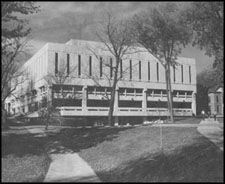Throwback Thursday: Carver Hall

Carver Hall, pictured from the southeast in 1969.
November 8, 2017
Carver Hall
In the photos, Carver Hall is pictured from the southeast in 1969 and again in 2017. In the modern photo, trees are now growing in the area that used to be empty and students are walking on the sidewalks.
Construction on Carver Hall began in 1967 and was finished in 1969. The primary purpose of the building was to add classrooms, lecture halls and office space for faculty as enrollment increased rapidly.
Carver Hall is currently home to the math and theatre departments, although classrooms are used by other department too.
The building was named Carver Hall in 1966 before construction started. It was named after George Washington Carver, a former student and instructor at Iowa State.
Carver is well known for finding over 300 uses for peanuts, although it is a common misconception that he was the inventor of peanut butter.
Carver is believed to have been born into slavery in 1864 in Diamond, Missouri, although his birth date is unknown.
Carver was kidnapped by raiders a week after his birth, along with his mother and sister and was sold in Kentucky. He was later found by an agent of his owner Moses and returned to Missouri.
After the abolishment of slavery in Missouri following the end of the Civil War, his former owner decided to keep Carver and his brother on the property to watch after and educate them. At that time, schools in the area did not accept African-American students.
After attending several schools, Carver graduated from Minneapolis High School in Minneapolis, Kansas.
While initially being accepted, Carver was denied admittance to Highland College in Highland, Kansas due to his race. He later went on to study music and art at Simpson College in 1890.
Carver’s time at Iowa State began in 1891. He was the first African-American student at Iowa State, and he decided to study botany.
After graduation he went on to head the Tuskegee Institute’s agriculture program in 1896. Under his leadership the program became nationally renown. Carver also developed a mobile classroom, which became known as the “Jesup Wagon.”
Aside from being a well-known agriculturist, Carver also advocated for “racial harmony” and toured colleges in the South for the Commission on Interracial Cooperation. Carver also used his savings to start a museum called the George Washington Carver Museum and Cultural Center, which featured some of his own work.
Carver died Jan. 5, 1943 after falling down the stairs at his house.















